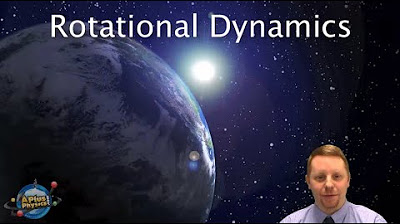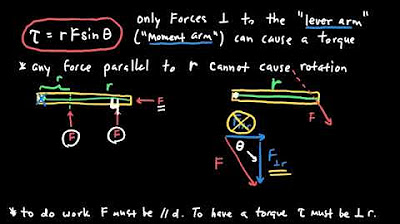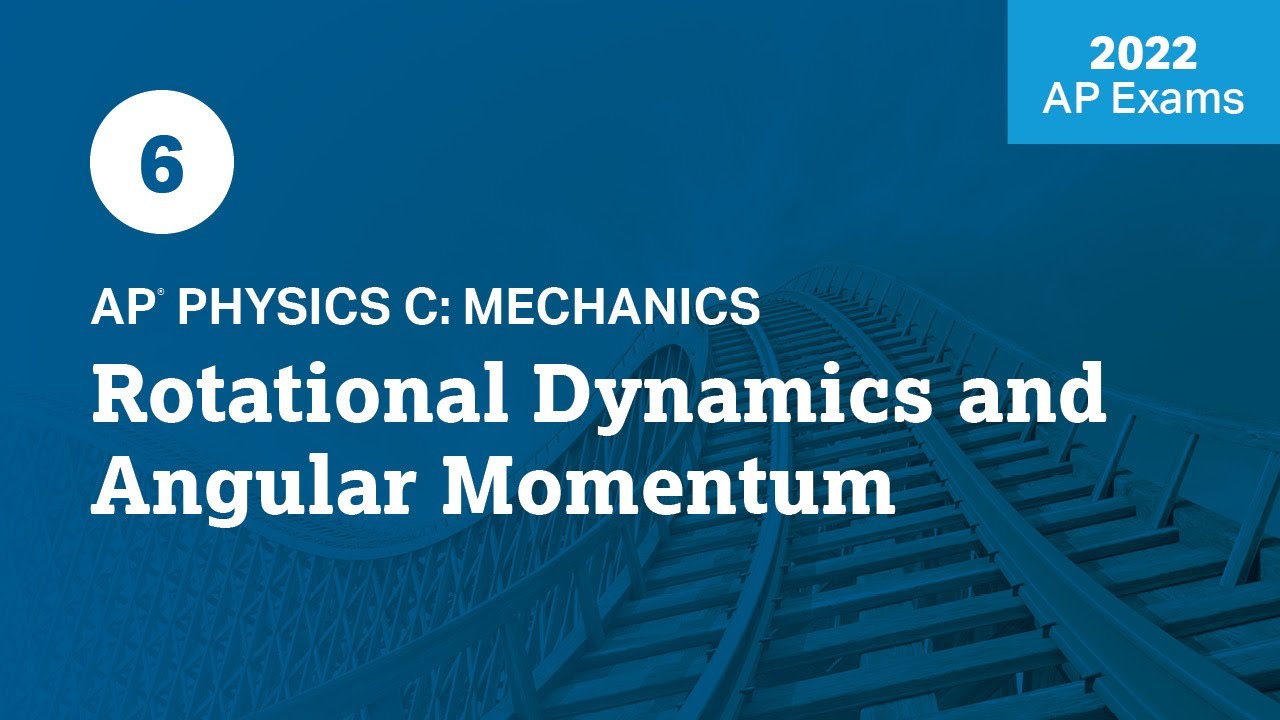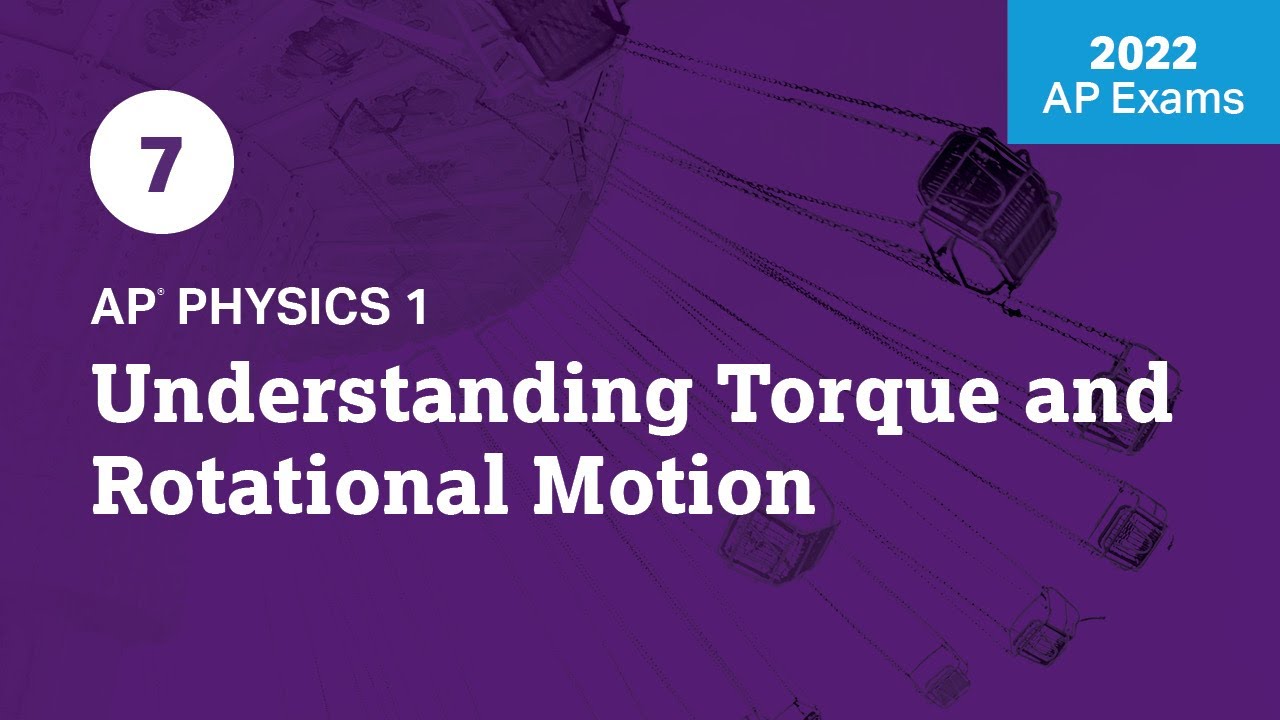AP Physics 1: Rotational Dynamics Review
TLDRIn this engaging lesson, Mr. P delves into the fundamentals of rotational dynamics as covered in the AP Physics 1 exam. Starting with the concept of torque, he explains its relation to angular acceleration and uses the everyday example of opening a door to illustrate the principle. The discussion then moves to the rotational form of Newton's second law, introducing the moment of inertia as a measure of resistance to angular acceleration. The lesson continues with an exploration of rotational kinetic energy, the conservation of mechanical energy in rolling objects, and the equations for the velocity of a rolling object's center of mass. Concluding with angular momentum and impulse, Mr. P emphasizes their vector nature and the significance of these concepts in understanding rotational dynamics. The lesson is a comprehensive review that effectively bridges theoretical concepts with practical applications.
Takeaways
- 📌 Torque (τ) is the ability to cause an angular acceleration of an object and is calculated as the lever arm (r) multiplied by the force.
- 🚪 Opening a door efficiently demonstrates the principle of torque; applying force further from the hinge (axis of rotation) results in greater torque.
- 🔢 The moment arm's effectiveness is maximized when force is applied at a 90-degree angle, as the sine of the angle (θ) equals one, leading to the maximum moment arm (r).
- 🏷️ Torque is a vector and is measured in Newton meters (Nm), which is equivalent to joules but is kept separate to distinguish it from energy.
- 🔄 The rotational form of Newton's second law states that the net torque (τ) equals the moment of inertia (I) times the angular acceleration (α).
- 🥊 Moment of inertia (I) is a measure of an object's resistance to angular acceleration and depends on the mass distribution relative to the axis of rotation.
- 🏓 The moment of inertia for a solid sphere is calculated as (2/5) times the mass times the radius squared.
- 💰 Rotational kinetic energy is given by (1/2) times the moment of inertia times the square of the angular velocity (ω) and is measured in joules (J).
- 🌐 When an object rolls without slipping, it has both translational and rotational kinetic energy, and a larger moment of inertia results in more rotational kinetic energy and less translational kinetic energy.
- 🚀 The velocity of the center of mass of a rolling object without slipping is the radius of the object times its angular velocity.
- 🔄 Angular momentum is the rotational equivalent of linear momentum and is calculated as the moment of inertia times the angular velocity (ω), with units of kilograms times meters squared divided by seconds (kg·m²/s).
Q & A
What is the symbol for torque?
-The symbol for torque is a lowercase tau (τ).
What does torque represent in physics?
-Torque represents the ability to cause an angular acceleration of an object.
What is the equation for torque?
-The equation for torque is the lever arm (or moment arm) multiplied by the force.
Why is it easier to open a door when you apply force farther from the hinge?
-Applying force farther from the hinge increases the moment arm (r perpendicular), which results in a larger torque and therefore a larger angular acceleration, making the door easier to open.
What is the most efficient angle to apply force on a door?
-The most efficient angle to apply force on a door is at 90 degrees to the door, as the sine of 90 degrees equals one, making the moment arm equal to r, which is the maximum value.
How is the direction of torque described?
-The direction of torque is described using clockwise and counterclockwise, as the AP Physics 1 curriculum does not include the right-hand rule.
What are the dimensions for torque?
-The dimensions for torque are Newton meters (N·m), which is equivalent to joules (J), but torque is kept in Newton meters to distinguish it from energy.
What is the rotational form of Newton's second law?
-The rotational form of Newton's second law states that the net torque is equal to the moment of inertia (I) times the angular acceleration.
How is the moment of inertia defined?
-The moment of inertia (I) is a measure of an object's resistance to angular acceleration and is defined as the sum of the mass of each particle times the square of the distance each particle is from the axis of rotation.
What is the relationship between moment of inertia and rotational kinetic energy?
-The moment of inertia (I) relates to rotational kinetic energy (KE) through the equation KE = 1/2 * I * angular velocity squared (ω^2). A larger moment of inertia means a larger rotational kinetic energy when an object rolls without slipping.
How can the velocity of the center of mass of a rolling object be calculated?
-The velocity of the center of mass (V_cm) of a rolling object without slipping can be calculated using the equation V_cm = radius of the object * angular velocity (ω).
What is angular momentum and how is it calculated?
-Angular momentum is a measure of the rotational motion of an object and is calculated as the moment of inertia (I) times angular velocity (ω). It has the dimensions of kilograms times meters squared divided by seconds (kg·m^2/s).
What is angular impulse and how does it relate to torque and angular momentum?
-Angular impulse is the change in angular momentum of an object and is equal to the net torque applied to the object multiplied by the change in time during a collision. It has the same dimensions as angular momentum, which are kilograms times meters squared over seconds (kg·m^2/s).
Outlines
📚 Introduction to Rotational Dynamics
This paragraph introduces the topic of rotational dynamics, which is a key area in the AP Physics 1 exam. The discussion begins with the concept of torque, its symbol (lowercase tau), and its definition as the ability to cause an angular acceleration of an object. The equation for torque is explained as the product of the lever arm (or moment arm) and the force applied. The real-world example of opening a door is used to illustrate how the position of the applied force affects the torque and consequently the ease of opening the door. The concept of moment arm and its relationship with the axis of rotation is detailed, emphasizing the maximum torque at a 90-degree angle. The paragraph also touches on the vector nature of torque and the lack of inclusion of the right-hand rule in the AP Physics 1 curriculum. The dimensions of torque (Newton meters) are related to joules, but the distinction between the two is clarified. The paragraph transitions into a discussion of the rotational form of Newton's second law, defining the moment of inertia as a measure of an object's resistance to angular acceleration. The formula for calculating the moment of inertia for a system of particles is provided, and examples of moments of inertia for specific rigid objects are discussed.
🚀 Rotational Kinetic Energy and Rolling Dynamics
The second paragraph delves into the concepts of rotational kinetic energy and the dynamics of an object rolling without slipping. It explains how both translational and rotational kinetic energies are gained as an object rolls down an incline, with a focus on the conservation of mechanical energy. The relationship between an object's moment of inertia and its rotational kinetic energy is explored, highlighting that a larger moment of inertia results in more rotational kinetic energy and less translational kinetic energy. The discussion continues with the impact of an object's moment of inertia on the time it takes to reach the bottom of an incline and its resulting linear velocity. The equation for the velocity of the center of mass of a rolling object is introduced and compared to the equation for tangential velocity. The paragraph concludes with an explanation of angular momentum, its vector nature, and its dimensions. The concept of angular impulse is introduced, relating it to the change in angular momentum during a collision and its dimensions. The review of rotational dynamics is summarized, and the viewer is directed to further resources for AP Physics 1 exam preparation.
Mindmap
Keywords
💡Torque
💡Angular Acceleration
💡Lever Arm
💡Moment of Inertia
💡Rotational Kinetic Energy
💡Rolling Without Slipping
💡Angular Momentum
💡Angular Impulse
💡Newton's Second Law - Rotational Form
💡Conservation of Mechanical Energy
Highlights
Torque is defined as the ability to cause an angular acceleration of an object.
The equation for torque is the lever arm (moment arm) multiplied by the force.
Applying force far from the hinge (axis of rotation) is more effective for opening a door, demonstrating the principle of torque.
The moment arm's efficiency is maximized when force is applied at a 90-degree angle, as the sine of the angle equals one.
Torque is a vector and its direction can be described as clockwise or counterclockwise.
Torque is measured in Newton meters, which is equivalent to joules, but they are kept separate to distinguish between vector and scalar quantities.
The rotational form of Newton's second law states that the net torque is equal to the moment of inertia times the angular acceleration.
The moment of inertia, or rotational mass, is a measure of an object's resistance to angular acceleration.
The moment of inertia for a system of particles is the sum of the mass of each particle times the square of its distance from the axis of rotation.
The moment of inertia for a solid sphere around its center of mass is calculated as 2/5 times the mass times the radius squared.
Rotational kinetic energy is calculated as 1/2 times the moment of inertia times the angular velocity squared, and is measured in joules.
An object rolling without slipping gains both translational and rotational kinetic energy, with a larger moment of inertia leading to more rotational kinetic energy.
The larger the moment of inertia of an object, the more time it takes to reach the bottom of an incline, resulting in a smaller linear velocity.
The velocity of the center of mass of a rigid object rolling without slipping is the radius of the object times its angular velocity.
Angular momentum is calculated as the moment of inertia times angular velocity, and like linear velocity, angular velocity is also a vector.
Angular impulse is equal to the change in angular momentum, which is the net torque applied during a collision multiplied by the change in time.
Angular impulse has the same dimensions as angular momentum, measured in kilograms times meters squared over seconds.
Transcripts
Browse More Related Video

AP Physics 1 - Rotational Dynamics

College Physics 1: Lecture 25 - Moment of Inertia and Rotational Dynamics

AP Physics 1 Torque and Rotational Motion Review

AP Physics 1 - 10 Minute Recap

2022 Live Review 6 | AP Physics C: Mechanics | Rotational Dynamics and Angular Momentum

2022 Live Review 7 | AP Physics 1 | Understanding Torque and Rotational Motion
5.0 / 5 (0 votes)
Thanks for rating: